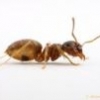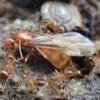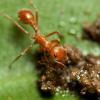Upon thinking it over, boosting is something that should only be done if your queen loses her first brood and is going to fail.
Or if you have a queen that did fail it might be okay to give her brood to another queen of that species. This past summer I found a Camponotus chromaiodes queen starting a colony in a log. While out hunting I came across an empty founding chamber (... apparently wood peckers, rodents, and squirrel sometimes chance upon them) but the brood was still in tact. I collected the brood and gave it to the queen. Because the resulting workers to both batches of brood will be callow workers, they accepted the new queen as their mother, no questions asked.
In the wild something like this often happens. In areas where new queens will/can be successful it's often the case that several dozen queens of that species have all landed in that location. In some genera it's common for queens to band together during the founding stage, Solenopsis, Lasius, Myrmecocystus etc... Others though can be far more fussy about starting together. Tetramorium and a fair amount (most?) Camponotus queens will attack one another on sight. Once the first workers are born though they begin foraging and these young colonies inevitably find one another. They begin combining (boosting) into larger colonies for the first 4 weeks or so, but after that a few things start happening. The colony odor sets in, the workers become defensive about the colony they've created, and they begin showing aggression towards other colonies whereas before they were more than happy to share food.
Within some species there are populations that are very open to the idea of keeping multiple queens alive for longer than a year. We see this a lot in Solenopsis invicta. I've some Monomorium colonies have hundreds of queens in them where as others seem to have far fewer or likely just one I was never able to find buried deep within the nest. Lastly, unless the species is parasitic, like Formica or Polyergus, the newly formed colony will STOP boosting with the brood of younger colonies.
Every documentary on Myrmecocystus raiding weak colonies of their species and stealing the brood and repletes is wrong! They state that the brood is added and they used to think this was correct because of genetic studies showing the DNA of one colony comes from multiple queens. But they were wrong. What was happening was after the colonies of Myrmecocystus were founded the queens would spread out within the nest, basically claiming their own section to lay eggs within. When scientists were digging these colonies up (in 110F heat, threw rock hard desert soil and stone) they were finding the first queen they came across and stopping, forgetting that these nests typically go 11 feet into the soil!



















